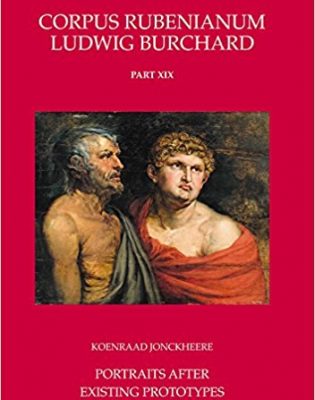Koenraad Jonckheere’s recent addition to the Corpus Rubenianum Ludwig Burchard, Portraits After Existing Prototypes, makes an important contribution to the understanding of a neglected but fascinating subsection of the master’s oeuvre. As Jonckheere notes, the designation of “copies” ill serves the works gathered together in this volume, a motley assembly of likenesses at least putatively derived from earlier sources (7-8). Instead of focusing on issues of attribution, the bread and butter of most Corpus volumes, Jonckheere approaches Rubens’s portrait copies (an unsatisfactory term I will use here for lack of a pithier alternative) as conceptual objects through which Rubens grappled with major issues of portrayal, verisimilitude, and the history of art. In Jonckheere’s words, “Conceived as reflections on art, they function…on various levels: as a copy, an imitation, a metaphor and an allegory” (17).
Surveying a wide range of Counter-Reformation and neo-Platonic writings on portraiture, Jonckheere gives a more historically nuanced positioning for Rubens’s practice in the genre than previous writers who have accepted wholesale the academic denigration of portraiture within a hierarchy of genres, an approach that Jonckheere critiques as “ahistorical and out of keeping with the views in the early seventeenth century, and even more with [portraiture’s] importance in early modern art history” (20). As might be expected from an insightful historian of iconoclasm, Jonckheere connects Rubens’s fascination with portraits to debates about likeness and simulacra in the Counter-Reformation. He convincingly puts to rest the notion that Rubens was attempting to assemble a “dynastic gallery,” either for himself or his Habsburg patrons (15-16). Instead, as Jonckheere demonstrates, portraits interested Rubens as works of art, as well as serving him as source material for history paintings. In this regard, the famously allusive and erudite artist viewed them in much the same light as he did ancient sculpture or gems.
In considering portrait copies as aesthetic objects, Jonckheere makes an important break with previous scholarship on these works. Wolfgang Stechow’s 1972 essay “Some Thoughts on Rubens as a Copyist of Portraits, 1610-1620,” provided the first extended scholarly discussion of this material, but also propounded the largely debunked dynastic gallery thesis. Instead, Jonckheere’s emphasis on imitation and emulation builds upon the essential foundation laid in Jeffrey Muller’s 1982 article “Rubens’s Theory and Practice of the Imitation of Art.” Nonetheless, Muller treated portraits as a category apart within Rubens’s relationship to the art historical past, writing, for example, in Rubens: The Artist as Collector (1989) that “Rubens painted and kept a large group of portraits for reasons of politics, friendship, honor, and familial love” (17), but not, implicitly, for reasons of art. More recently, in her own Corpus volume on Rubens’s copies from Northern Renaissance prototypes, Kristin Belkin declared his frequent practice of copying portraits “surprising,” but explained that “the reasons for this are not so much artistic as political or social…the attraction of the older image lies not only in its artistic merits but also in its value as a biographical document” (56). Meanwhile, Jeremy Wood’s multiple Corpus volumes on Rubens’s copies after Italian masters offer rich individual entries on portrait copies, but without providing the sort of global view of portraiture that Jonckheere attempts here.
Against what might be termed the antiquarian or biographical approach to Rubens’s portrait copies, Jonckheere undertakes a richly layered reading of one of the greatest of these works, the portrait of Charles the Bold (Vienna, Kunsthistorisches Museum), which provides a touchstone for the volume as a whole. Not a copy of any single original, Charles the Bold is instead “a work of art in which nature, old masters, antiquity … and particularly inventio merge in a sublime aemulatio…With his Portrait of Charles the Bold Rubens announces himself as a modern Zeuxis, combining the best of art and nature to ‘fashion’ a divine Helen from the fairest parts of many models, yet adding perfection uyt den gheest” (13-14). In his reading of this work, Jonckheere successfully demonstrates just what a multifaceted object of interpretation a “copy” can be.
However, as Jonckheere readily concedes, “Not all the ‘copies of extant prototypes’ are as exemplary as the Portrait of Charles the Bold” (48). In fact, many of the works gathered in the slender catalogue appended to Jonckheere’s essay, such as the heads of illustrious men at Antwerp’s Plantin-Moretus Museum or the emperors from Stuttgart’s Staatsgalerie, will appeal only to the most diehard of Rubens completists. But whatever their aesthetic demerits, these works do prompt Jonckheere to an interesting discussion of Rubens’s commercial practice, in particular his willingness to claim works of low quality as his own productions. Jonckheere also makes the intriguing suggestion that the sketch-like oval portraits of emperors from another series, now dispersed across various collections, were originally intended for display in the so-called Pantheon of the Rubenshuis.
A major drawback of the catalogue is the absence of many of the most important and compelling of Rubens’s portrait copies. These range from the striking Mulay Ahmad (Boston, Museum of Fine Arts), after Jan Vermeyen, to the Sir Thomas More, after Holbein and now in the Prado. Both of these paintings received substantial entries in Belkin’s Corpus volumes on copies after Northern Renaissance art, while the major portrait copies after Raphael and Titian are admirably discussed in Jeremy Wood’s own contributions to the series. Jonckheere’s desire to avoid overlap with other works in the Corpus is understandable. But his approach to this material departs significantly enough from his fellow authors that I would have appreciated his commentary on these important paintings as well. A casual reader unfamiliar with Rubens’s portrait copies may get a distorted sense of them if she or he consults only Jonckheere’s catalogue, unaware that so many of the most important portrait copies are treated elsewhere. This is regrettable in a book that otherwise makes an important contribution toward vindicating an often overlooked body of work.
Adam Eaker
Metropolitan Museum of Art
